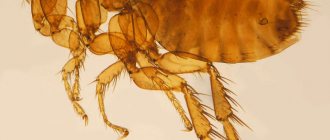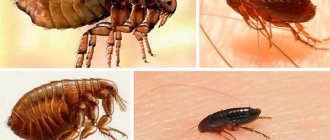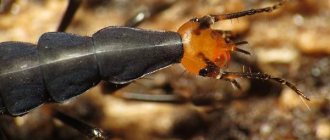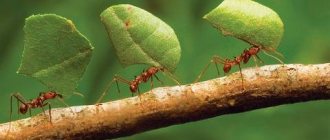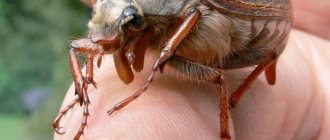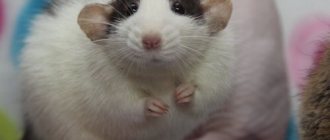The green grasshopper is a beautiful large insect of bright green or light green color with long translucent wings. Residents of Russia are well acquainted with the green grasshopper, as it lives in almost all landscape areas of the country. Only the climatic conditions of the northern regions are unfavorable for its existence.
The characteristic natural color serves as an excellent means of camouflage for the green grasshopper, which lives mainly in grasses and bushes. From mid-summer to late autumn it can be found in gardens, on the edges of forests, along the edges of fields and meadows. In desert areas, the green grasshopper prefers the edges of tugai forests and river valleys. In Central Asia, it climbs high into the mountains to hide in gorges with lush herbaceous plants. This insect can also be found in many other countries: in European countries (except for Northern European countries), Mongolia, Northern India, countries of Western Asia, Afghanistan, Western China.
Description of the appearance of the insect
The body of an adult insect, like the body of a larva, has a rich green color. Only on the wings and chest there may sometimes be dark spots. Body length – 28–36 mm. The antennae are very long, bristle-like, with a reddish tint. The length of the green grasshopper's whiskers exceeds the length of the insect's body. The grasshopper has 2 pairs of wings - front and rear. The hind wings are wide, transparent, with thin veins forming an abstract geometric pattern; the front ones are denser and narrower. At rest, the hind wings are hidden under
In front of them. The length of the wings exceeds the length of the insect's abdomen by almost 2 times. The head has an elongated shape. The eyes are round and protruding. The upper part of the pronotum has a convex or flat shape. The type of mouthparts is gnawing.
Females differ from males in the presence of a long saber-shaped or xiphoid ovipositor compressed from the sides. The hind limbs of males are much longer than the forelimbs. The hearing organs are oval membranes located on the shins of the forelimbs on both sides. In males, the elytra are equipped with a chirping organ, which is formed by a stridulatory part and a transparent resonating membrane (speculum).
Structure
External characteristics of the grasshopper:
- Flattened body on both sides
- Head with big eyes
- 3 pairs of legs,
- Wings.
They move with the help of their front legs, and with the help of their more muscular hind legs, insects jump quite long distances. The length of the jump is 20 times greater than the insect's body.
The length of a grasshopper depends on the species and ranges from 1 to 5 cm, but there are some individuals whose size reaches 15 cm. Which is comparable to the length of a praying mantis.
The whiskers serve as the insect's sense of touch. An interesting fact is that the longer the length of the antennae, the higher the higher place the grasshopper occupies on the hierarchical ladder among its relatives.
The wings have a direct function and help the grasshopper take off and fly short distances.
Some subspecies have an additional pair of wings that perform a protective or safety function for the main wings.
Lifestyle
Green grasshoppers lead a solitary lifestyle. They jump and fly very well.
The length of the jump is several times greater than the length of the insect itself, and the flight speed can reach up to 1.5 km/h.
Grasshoppers do not have a home; they are always found among grass, bushes and trees. In particularly hot weather, the insect hides in the greenery all day, emerging from shady shelters only early in the morning.
We hear the ringing melodies of the grasshopper throughout the summer. The sound occurs as a result of vibration and becomes even louder if the insect raises its wings. Males sing to attract females or to let other males know that the territory is already occupied. The chirping of a grasshopper can most often be heard in the daytime and evening, less often at night.
How does a grasshopper live?
The lifestyle directly depends on the type of grasshopper and its characteristic features.
A common green grasshopper has a body length of up to 4 mm. This is believed to be the most common group.
As for orange grasshoppers, they were brought to us from China. You can only see them in greenhouses.
The largest grasshopper is considered to be the Giant Weta. It weighs about 80 grams.
Grasshoppers are not pests for humans and agricultural land. And some peoples have long included these insects in their daily diet.
If a grasshopper feels threatened by a person, it may bite him. The bites received from this insect are quite painful, because it has a powerful jaw.
Some people like the grasshopper's singing, and in order to continue to listen to it constantly, people have come up with an artificial habitat for maintaining a home - insectariums.
Reproduction
Mating of green grasshoppers occurs within 45 minutes. After mating, the female begins to eat the spermatophore. This process can last up to 15 hours. The male resumes his chirping within 15 minutes after mating.
Egg laying occurs at the end of summer. To do this, the female selects a suitable place in the soil and lays up to 100 eggs in a shallow hole. The eggs are elongated, cylindrical, greenish in color. Egg length up to 6 mm.
Adults die with the onset of cold weather, and the eggs continue to be in the soil at a shallow depth throughout the fall and winter. In the spring, when the surface layer of the earth begins to warm up, larvae hatch from the eggs. During their development, they molt 5 times. Then, bypassing the pupal stage, the larva will turn into a young grasshopper.
Singing grasshopper keeping a home
Many people may think that the singing grasshopper is an excellent pet to keep at home, but actually they are right.
If you are not bothered by the fact that the pet will not live long, and will chirp without a female in a pair, then feel free to drag it home. It is not difficult to make a terrarium for a song grasshopper; any container with sufficient ventilation, approximately 40x30x30 in size for 2-3 song grasshoppers, will do. Read how to make an insectarium with your own hands. Information about the amount of space required was taken from the Internet; at home I kept them in spartan conditions, about 5-6 individuals in a 12-liter aquarium in a vertical orientation, gradually feeding them to the spider.
It is recommended to sprinkle sawdust at the bottom of the container, and place a jar of wet peat in the corner, into which the female will lay larvae. I think any substrate will do, even soil from the street, with the proviso that you will then have to look for the eggs of the singing grasshopper by hand. You should also place various driftwood and sticks in the container to increase the usable area and allow the grasshopper to climb branches.
The singing grasshopper should be fed with insects; at home, you can feed it with food insects such as marbled cockroaches or Turkmen cockroaches; you should also offer greens in the form of various plants from the street.
Song grasshopper eggs along with the substrate should be removed at the end of August and placed in the refrigerator until the end of February. Then they are removed and the little singing grasshoppers are waited for to emerge.
I hope you liked the article and it was informative; you can see photographs of other insects in Russia in the special
Insect nutrition
Green grasshoppers are predatory insects. They feed mainly on butterflies,
caterpillars and other small insects, sometimes eating larvae or weaker representatives of their species. Grasshoppers wait for their prey, sitting quietly in the grass, grab it tightly with their 4 front legs and immediately eat it.
If difficulties arise in finding insects, grasshoppers can feed on plant foods: flowers, foliage, tree buds, plant stems, grass and some cereals.
Types of grasshoppers, photos and names
Below is a brief description of some grasshoppers.
- Dybki (Saga)
These are large grasshoppers living in Europe, Asia, South Africa, Australia and North America.
Steppe dybka
- Green grasshopper (Tettigonia viridissima)
Insect 2.5 - 4 mm long. This species lives throughout Europe, Asia, Africa, in the middle zone and in the south of Russia.
Grasshopper green
- Greenhouse grasshopper (Tachycines asynamorus)
Small insects that look like spiders. Introduced to Europe and America from China, they live in greenhouses and greenhouses, feeding on the leaves and flowers of plants.
Greenhouse grasshopper
- Ball-headed grasshoppers (Bradyporidae)
Orthoptera, long-whiskered insects with a spherical head. These include the steppe fatty - a large black-bronze grasshopper. This species, listed in the Red Book, lives in the Krasnodar and Stavropol Territories, in Chechnya and North Ossetia;
Steppe fat man
By the way, the largest grasshopper in the world is the Giant Weta, whose impressive weight reaches 70-80 grams.
The world's smallest grasshopper is the greenhouse grasshopper.
The world's largest grasshopper is the Giant Weta.
Maliciousness
Very often, the green grasshopper damages vineyards by eating flowers, leaves and buds. The grasshopper often harms tobacco crops, citrus fruits, tea leaves and other plants.
The most dangerous caterpillar, contact with which can lead to death, is Lonomy. Have you planted a beautiful boxwood bush and are afraid for its safety? Find out how to protect your plant from its biggest enemy. Read more here.
If you need to treat indoor or garden plants against spider mites, then choose Masai acaricide. What are its advantages, read the link.
What do grasshoppers eat?
Many people believe that grasshoppers are exclusively herbivores. However, this opinion cannot be called absolutely correct. Of course, these insects enjoy eating leaves and grass, but they are not vegetarians, since they are no less attracted to meat delicacies in the form of mites, small beetles, larvae and butterflies.
However, unlike locusts, which can destroy a farmer's future crop in a short time, grasshoppers bring benefits - for example, they help fight the Colorado potato beetle, which attacked a potato field. But when grasshoppers are kept autonomously, for example, in a closed jar, in the absence of food, cannibalism is not excluded - in order not to die of hunger, stronger individuals feed on weaker ones.
Control measures
Methods to combat this insect have not yet been sufficiently developed. For preventive and exterminatory purposes, the following is recommended:
- It is advisable to locate tobacco plantations away from egg-laying sites (thrush and virgin areas) of the green grasshopper;
- treatment of the shag field and surrounding area with internal poisons;
- placement of bait with poison in pest habitats. This will require 30–60 kg of bran, 24 liters of water, 0.8–1.2 kg of arsenous soda.
Interesting facts about the grasshopper
- With the exception of some species of grasshoppers that readily eat tea and citrus plantations, these insects do not cause much harm. In Chinese cuisine, grasshopper is a common ingredient and is also included in the regular menu of African and Asian aborigines.
- Thanks to its powerful jaws, a grasshopper bite, accompanied by a death grip, can be very painful for humans.
- Sweet-sounding insects, grasshoppers are often kept in captivity as pets. Several individuals are placed in a spacious aquarium - an insectarium, the bottom is covered with sand and a little vegetation is added. A dense diet consisting of fruits, vegetables and the obligatory live food: flies, spiders and butterflies will help to avoid the cannibalism inherent in insects.
Did you like the article? Share with your friends:


